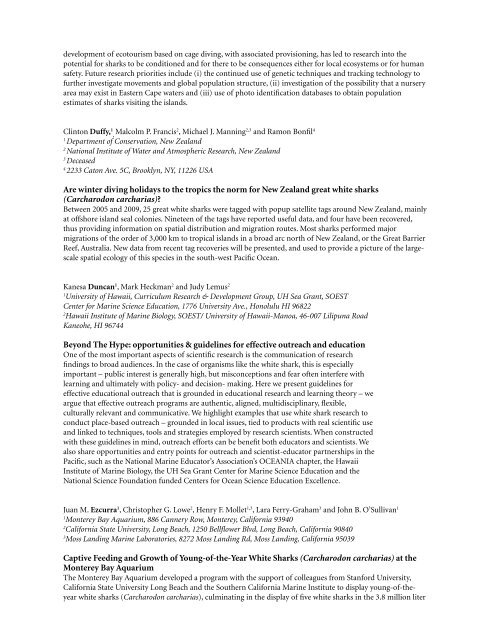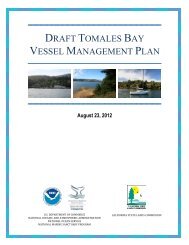Symposium program - Gulf of the Farallones National Marine ...
Symposium program - Gulf of the Farallones National Marine ...
Symposium program - Gulf of the Farallones National Marine ...
Create successful ePaper yourself
Turn your PDF publications into a flip-book with our unique Google optimized e-Paper software.
development <strong>of</strong> ecotourism based on cage diving, with associated provisioning, has led to research into <strong>the</strong><br />
potential for sharks to be conditioned and for <strong>the</strong>re to be consequences ei<strong>the</strong>r for local ecosystems or for human<br />
safety. Future research priorities include (i) <strong>the</strong> continued use <strong>of</strong> genetic techniques and tracking technology to<br />
fur<strong>the</strong>r investigate movements and global population structure, (ii) investigation <strong>of</strong> <strong>the</strong> possibility that a nursery<br />
area may exist in Eastern Cape waters and (iii) use <strong>of</strong> photo identification databases to obtain population<br />
estimates <strong>of</strong> sharks visiting <strong>the</strong> islands.<br />
Clinton Duffy, 1 Malcolm P. , Francis2 , Michael J. Manning 2,3 and Ramon Bonfil 4<br />
1<br />
Department <strong>of</strong> Conservation, New Zealand<br />
2<br />
<strong>National</strong> Institute <strong>of</strong> Water and Atmospheric Research, New Zealand<br />
3<br />
Deceased<br />
4<br />
2233 Caton Ave. 5C, Brooklyn, NY, 11226 USA<br />
Are winter diving holidays to <strong>the</strong> tropics <strong>the</strong> norm for New Zealand great white sharks<br />
(Carcharodon carcharias)<br />
Between 2005 and 2009, 25 great white sharks were tagged with popup satellite tags around New Zealand, mainly<br />
at <strong>of</strong>fshore island seal colonies. Nineteen <strong>of</strong> <strong>the</strong> tags have reported useful data, and four have been recovered,<br />
thus providing information on spatial distribution and migration routes. Most sharks performed major<br />
migrations <strong>of</strong> <strong>the</strong> order <strong>of</strong> 3,000 km to tropical islands in a broad arc north <strong>of</strong> New Zealand, or <strong>the</strong> Great Barrier<br />
Reef, Australia. New data from recent tag recoveries will be presented, and used to provide a picture <strong>of</strong> <strong>the</strong> largescale<br />
spatial ecology <strong>of</strong> this species in <strong>the</strong> south-west Pacific Ocean.<br />
Kanesa Duncan 1 , Mark Heckman 2 and Judy Lemus 2<br />
1<br />
University <strong>of</strong> Hawaii, Curriculum Research & Development Group, UH Sea Grant, SOEST<br />
Center for <strong>Marine</strong> Science Education, 1776 University Ave., Honolulu HI 96822<br />
2<br />
Hawaii Institute <strong>of</strong> <strong>Marine</strong> Biology, SOEST/ University <strong>of</strong> Hawaii-Manoa, 46-007 Lilipuna Road<br />
Kaneohe, HI 96744<br />
Beyond The Hype: opportunities & guidelines for effective outreach and education<br />
One <strong>of</strong> <strong>the</strong> most important aspects <strong>of</strong> scientific research is <strong>the</strong> communication <strong>of</strong> research<br />
findings to broad audiences. In <strong>the</strong> case <strong>of</strong> organisms like <strong>the</strong> white shark, this is especially<br />
important – public interest is generally high, but misconceptions and fear <strong>of</strong>ten interfere with<br />
learning and ultimately with policy- and decision- making. Here we present guidelines for<br />
effective educational outreach that is grounded in educational research and learning <strong>the</strong>ory – we<br />
argue that effective outreach <strong>program</strong>s are au<strong>the</strong>ntic, aligned, multidisciplinary, flexible,<br />
culturally relevant and communicative. We highlight examples that use white shark research to<br />
conduct place-based outreach – grounded in local issues, tied to products with real scientific use<br />
and linked to techniques, tools and strategies employed by research scientists. When constructed<br />
with <strong>the</strong>se guidelines in mind, outreach efforts can be benefit both educators and scientists. We<br />
also share opportunities and entry points for outreach and scientist-educator partnerships in <strong>the</strong><br />
Pacific, such as <strong>the</strong> <strong>National</strong> <strong>Marine</strong> Educator’s Association’s OCEANIA chapter, <strong>the</strong> Hawaii<br />
Institute <strong>of</strong> <strong>Marine</strong> Biology, <strong>the</strong> UH Sea Grant Center for <strong>Marine</strong> Science Education and <strong>the</strong><br />
<strong>National</strong> Science Foundation funded Centers for Ocean Science Education Excellence.<br />
Juan M. Ezcurra 1 , Christopher G. Lowe 2 , Henry F. Mollet 1,3 , Lara Ferry-Graham 3 and John B. O’Sullivan 1<br />
1<br />
Monterey Bay Aquarium, 886 Cannery Row, Monterey, California 93940<br />
2<br />
California State University, Long Beach, 1250 Bellflower Blvd, Long Beach, California 90840<br />
3<br />
Moss Landing <strong>Marine</strong> Laboratories, 8272 Moss Landing Rd, Moss Landing, California 95039<br />
Captive Feeding and Growth <strong>of</strong> Young-<strong>of</strong>-<strong>the</strong>-Year White Sharks (Carcharodon carcharias) at <strong>the</strong><br />
Monterey Bay Aquarium<br />
The Monterey Bay Aquarium developed a <strong>program</strong> with <strong>the</strong> support <strong>of</strong> colleagues from Stanford University,<br />
California State University Long Beach and <strong>the</strong> Sou<strong>the</strong>rn California <strong>Marine</strong> Institute to display young-<strong>of</strong>-<strong>the</strong>year<br />
white sharks (Carcharodon carcharias), culminating in <strong>the</strong> display <strong>of</strong> five white sharks in <strong>the</strong> 3.8 million liter







